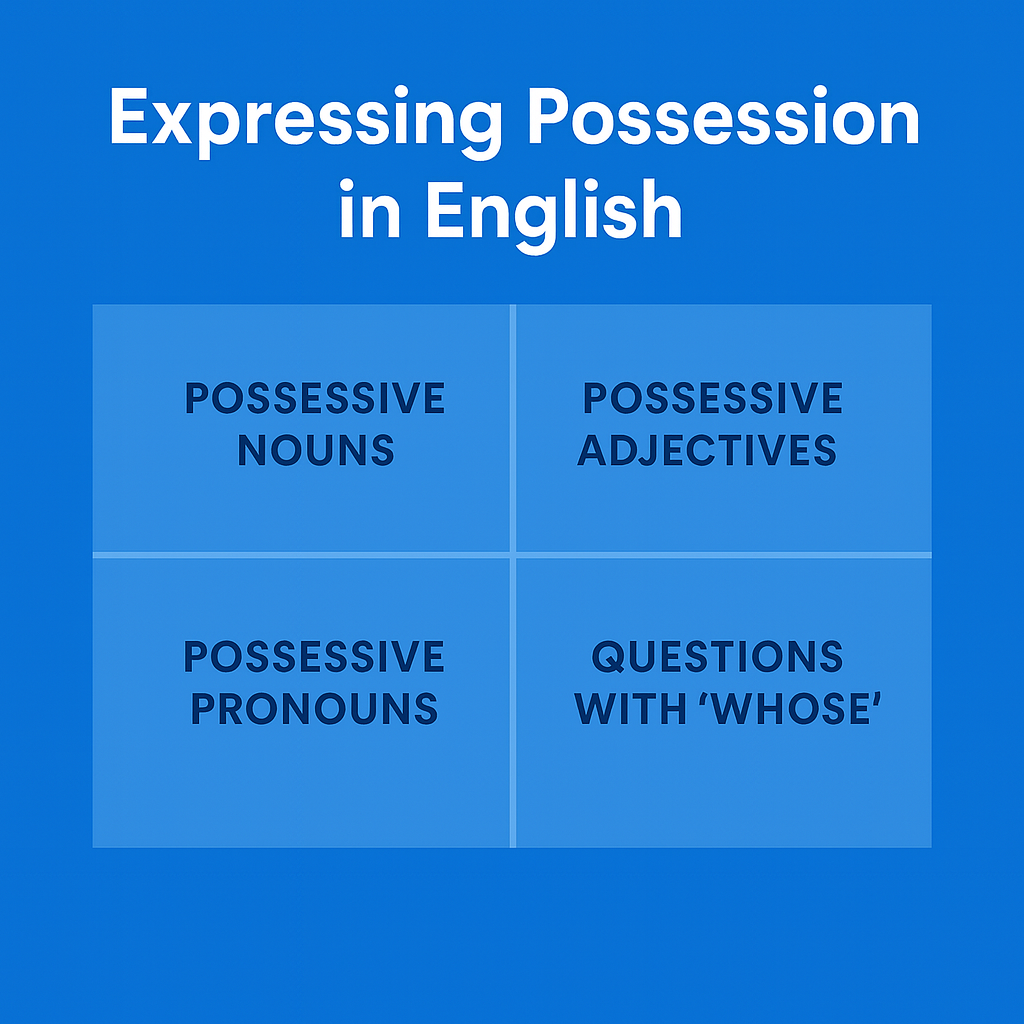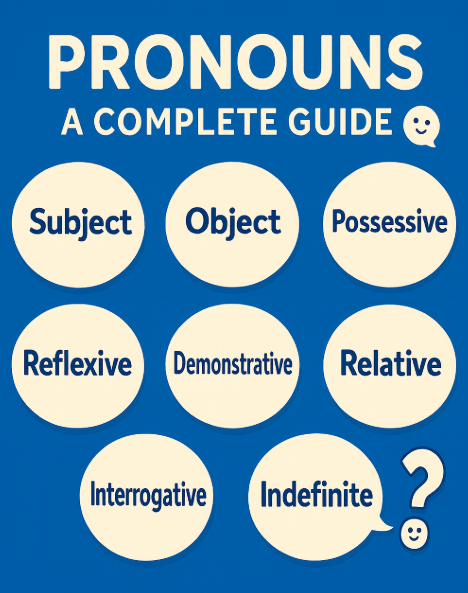In English, we often need to make statements or ask questions about possession – ownership. Possessives help us do this in different ways: with possessive nouns, possessive adjectives, possessive pronouns, and with the question word ‘whose‘.
This lesson will help you understand how to use each form with simple rules, clear examples, and common mistakes to avoid. You will also be able to test your knowledge of the material. By the end, you’ll be more confident using different types of possessives.
What Are Possessive Nouns in English?
When we want to show that something belongs to someone or something, we use possessive nouns.
How to Make a Possessive Noun
For most singular nouns, add ’s (apostrophe + s).
- That is Maria’s book.
- The dog’s toy is under the couch.
- Those are the student’s books.
- The teacher’s computer is on the desk.
For plural nouns that already end in s, just add an apostrophe (’).
- The teachers’ room is next to the library.
- The students’ teacher is in front of the class.
- The dogs’ food is in the bowl.
- My parents’ car is red.
For irregular plural nouns (that don’t end in s), add ’s.
- The children’s shoes are in the bedroom.
- The men’s jackets are grey.
- The women’s department is on the third floor.
- The sheep’s wool is soft.
Common Mistakes with Possessive Nouns
Don’t forget the apostrophe (’).
❌ Marias book
✅ Maria’s book
Be careful with plural nouns.
❌ The students teacher
✅ The students’ teacher
Don’t use “of” and ’s together.
❌ The book of Maria’s
✅ Maria’s book / The book of Maria
👉 Grammar Tip!
Don’t confuse the ‘s with a possessive noun with the contraction of a noun and the Be verb ‘is.’ A noun comes after the possessive noun.
- The cat’s toy is under the couch (Possessive)
- The cat’s under the couch (Contraction of the noun ‘cat’ and the Be verb ‘is’).
Possessive Adjectives Explained (my, your, his, her, its, our, their)
We use possessive adjectives to show that something belongs to someone. Possessive adjectives come before a noun.
| Subject Pronouns | Possessive Adjectives | Examples |
|---|---|---|
| I | My | This is my book. |
| You | Your | That is your pen. |
| He | His | This is his bag. |
| She | Her | That is her phone. |
| It | Its | The dog eats its food. |
| We | Our | This is our classroom. |
| They | Their | Those are her shoes. |
🔗 Read Our Guide on Subject Pronouns
👉 Grammar Tip!
Possessive adjectives are not plural. They always stay the same.
✅ This is my book. / These are my books.
Be careful with its (no apostrophe).
Its = possession → The cat licked its paw.
It’s = the contraction of ‘it is’ → It’s a sunny day.
Sentences Using Possessive Adjectives
- I visit my family on Saturdays.
- You have your homework.
- He likes his guitar.
- She is talking to her teacher.
- The bird is in its cage.
- We are eating our lunch.
- They are watching their favorite movie.
Common Mistakes with Possessive Adjectives
❌ This is me book.
✅ This is my book.
👉 Remember: use my, not me.
❌ She is playing with her’s doll.
✅ She is playing with her doll.
👉 Don’t add ’s to possessive adjectives.
❌ That is your’s pen.
✅ That is your pen.
👉 Again: no apostrophe in possessive adjectives.
❌ This is mine pencil.
✅ This is my pencil.
👉 Mine is a possessive pronoun. Use my before nouns.
❌ He is doing he homework.
✅ He is doing his homework.
👉 Each subject has its own special form.
👉 Grammar Tip!
Possessive adjectives always go before a noun:
- my book
- your phone
- our teacher
Possessive Pronouns in English (mine, yours, his, hers, ours, theirs)
We use possessive pronouns to show that something belongs to someone. Unlike possessive adjectives, possessive pronouns stand alone. They do not come before a noun.
| Subject Pronouns | Possessive Adjectives | Possessive Pronouns | Examples |
|---|---|---|---|
| I | My | Mine | This book is mine. |
| You | Your | Yours | That pen is yours. |
| He | His | His | The bag is his. |
| She | Her | Hers | The phone is hers. |
| It | Its | * | * |
| We | Our | Ours | The classroom is ours. |
| They | Their | Theirs | The shoes are theirs. |
👉 Grammar Tip!
Possessive pronouns replace the noun.
This is my book. (possessive adjective + noun)
✅ This is mine. (possessive pronoun)
Do not use both at the same time.
❌ This is my book mine.
✅ This is my book. / This is mine.
Examples of Possessive Pronouns in Sentences
- That is your pencil. This pencil is mine. (mine = my pencil)
- That is her car. The blue car is yours. (yours = your car)
- Those are his books. These are his. (his = his books)
- Her jacket is black. Hers is blue. (Hers = her jacket)
- Our house is big. Ours is small. (Ours = our house)
- Their toys are in the bedroom. Theirs are in the closet. (Theirs = their toys)
Common Mistakes with Possessive Pronouns
❌ This is my book mine.
✅ This is my book. / This is mine.
👉 Don’t use a possessive adjective (my) and a possessive pronoun (mine) together.
❌ That is your’s.
✅ That is yours.
👉 Never add an apostrophe to possessive pronouns.
❌ These are our’s bags.
✅ These are ours.
👉 Possessive pronouns stand alone, without nouns after them.
❌ This is her. (when you mean possession)
✅ This is hers.
👉 Her is an adjective, hers is the pronoun.
❌ The house is their.
✅ The house is theirs.
👉 Always use the full possessive pronoun.
👉 Grammar Tip!
Use possessive adjectives (my, your, his) before nouns, but use possessive pronouns (mine, yours, his) without nouns.
🔗 Read Our Complete Guide on Pronouns
How to Ask Questions with Whose
We use whose to ask about ownership or possession. It means Who does this belong to?
Whose + Noun + Is This/Are These?
- Whose pen is this? → It’s my pen.
- Whose shoes are these? → They are her shoes.
You can also ask without the noun:
- Whose is this?
- Whose are these?
Answering Whose Questions (Adjectives and Pronouns)
With a possessive adjective:
- Whose book is this? → It’s my book.
- Whose car is that? → It’s our car.
With a possessive pronoun:
- Whose book is this? → It’s mine.
- Whose shoes are these? → They’re hers.
Examples of Possessive Pronouns in Sentences
- Whose backpack is this? → It’s his.
- Whose phone is on the table? → It’s mine.
- Whose tickets are these? → They’re theirs.
- Whose dog is in the yard? → It’s our dog.
Common Mistakes with Whose vs. Who’s
❌ Who’s book is this?
✅ Whose book is this?
👉 Grammar Tip!
Use whose to ask who owns something. Be careful not to confuse it with who’s (who is).
- Whose = possession (Whose pen?)
- Who’s = who is (Who’s at the door?)
FAQ: Possessive Nouns, Adjectives, Pronouns, and Whose
1. What is the difference between a possessive adjective and a possessive pronoun?
A possessive adjective comes before a noun (my book, their house). A possessive pronoun replaces the noun (mine, theirs).
2. Can we use ‘its’ with an apostrophe at the end?
No. The correct form is ‘its’ (no apostrophe). It’s means it is.
3. How do I know if I should use ’s or s’ in possessive nouns?
- Add ’s for singular nouns (the dog’s toy).
- Add only an ’ for plural nouns that end in s (the students’ teacher).
4. Do we use “whose” for things or only for people?
You can use whose for both people and things.
- Whose pen is this? (thing)
- Whose brother is he? (person)
5. What are the most common mistakes with possessives?
- Adding an apostrophe to possessive adjectives (❌ your’s).
- Using both forms together (❌ This is my book mine).
- Confusing whose (possession) and who’s (who is).
Let’s Practice!
Exercise A
Fill in the blank with the correct possessive noun.
- This is ______ (Charles) book.
- The _____ (boys) coach is tough.
- The _____ (children) teacher gives too much homework!
- We visited my ______ (friend) apartment.
- The _____ (woman) purse cost $5,000.
Exercise B
Complete each sentence with a possessive adjective.
- The students have class at 9:00am. _____ class is on the first floor.
- Diego and I are in the same class. _____ class starts at 9:00am.
- The woman is from Mexico City. _____ name is Frida.
- I have a dog. _____ hair is short.
- You are late to class. Where is _____ homework?
Exercise C
Complete each sentence with a possessive pronoun.
- I have my favorite teacher and my classmates have ______.
- My car is fast. Is _____ fast, too?
- Can I borrow your calculator? I left _____ at home.
- Their teacher doesn’t give a lot of homework. ______ gives homework everyday!
- Diego has his friends and his sister has ______ .
- I lost my wallet. John didn’t lose _____.
Exercise D
Match the beginning of the sentence with the correct ending.
a. Who
b. Whom
c. Whose
d. Who’s
1. _____ is from Latin America?
2. _____ in the library now?
3. _____ backpack is under the desk?
4. _____ does she want to date?
Scoring & Feedback
🔵 17 – 20 correct
Excellent work! 🎉You really understand possessives. Keep using them in your everyday conversations and writing.
🟢 14 – 16 correct
Great job! ✅ You know most of the possessives. Review the ones you missed.
🟡 7 – 13 correct
Good effort! 💪You’re learning, and that’s what matters. Take a moment to review the examples and do the quiz again.
🔴 0–6 correct
No worries! 🌱 Possessives can be tricky at first. Go back and review the examples in the lesson.
Want more reading, writing, listening, and speaking practice? Check out the Essential English series on Amazon!
Conclusion
Possessive Nouns, Possessive Adjectives, Possessive Pronouns, and questions with ‘Whose’ are important words in English. Use them every day and you will become more confident. Feel free to share your thought or ask any question in the comments below.


